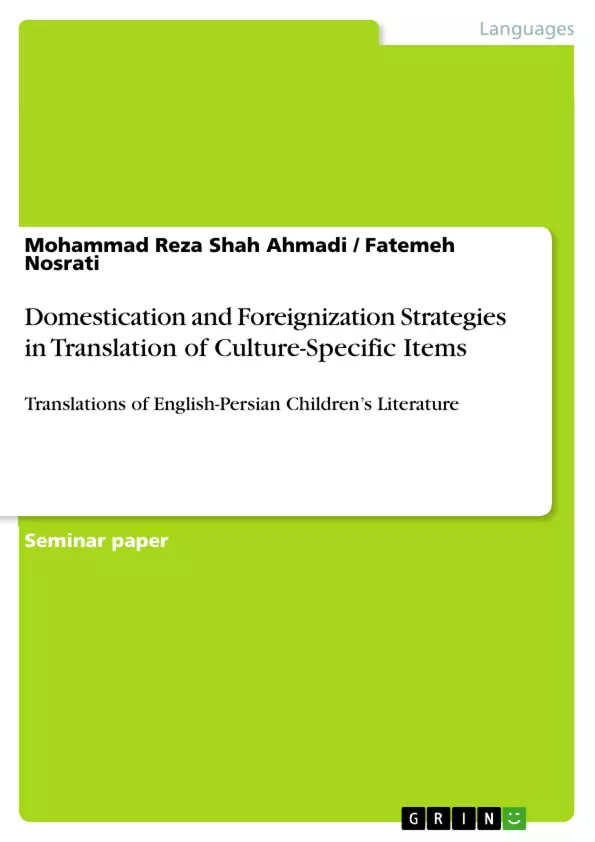Culture-bound elements, such as proper names, food items, and idioms not only place the story of a book in a specific culture and period of time, but also imply certain values. These elements also have an effect on how the reader identifies with the story and characters. So, it is important to find the most appropriate strategy to translate such elements.
The objective of this paper is to find out what the most frequently used strategy in translation of culture-specific items in children’s literature is. To this end, Venuti’s (1995) model of domestication and foreignization strategies was adopted as the framework. The culture-bound terms were classified based on Toponyms, Anthroponyms, Means of transportation, Date, Food and Drink, Idioms, Measuring system, Scholastic reference. In the process of tracking down the culture-specific items the model proposed by Pedersen (2005) has been used.
To collect and analyze the data, first, the researcher compared ten successive pages, selected randomly, of each of the selected English children’s stories (Daddy long legs by Jean Webster, Anne- of- Green-Gables by Lucy Maud Montgomery, the Adventures of Tom Sawyer by Mark Twain, and The Prince and the Pauper by Mark Twain) with their Persian translation to identify culture-specific items. Next, the strategies used by the translator were identified and their frequency was calculated. The results, then, were presented in some tables.
According to the obtained results, although both domesticating and foreignizing strategies have been used, foreignization has been the most dominant cultural translation strategy in children’s literature.
Inhaltsverzeichnis (Table of Contents)
- Introduction
- Statement of the Problem
- Research Question
- Hypothesis
- Key Words
- Limitations
- Delimitations
- Review of the Related Literature
- Children's Literature
- Domestication and Foreignization
Zielsetzung und Themenschwerpunkte (Objectives and Key Themes)
This paper examines the translation strategies used in translating culture-specific items in English-Persian children's literature. The main objective is to determine the most frequently used strategy between domestication and foreignization. The study focuses on the following key themes:- The role of culture-specific items in children's literature
- The impact of translation strategies on the reader's experience
- The application of domestication and foreignization in children's literature
- The analysis of culture-specific items in specific English children's stories and their Persian translations
- The frequency of domestication and foreignization strategies used by translators
Zusammenfassung der Kapitel (Chapter Summaries)
The introduction outlines the importance of culture-specific items in children's literature and highlights the impact these elements have on the reader's connection to the story and characters. The study aims to investigate the most prevalent strategy in translating culture-specific items in children's literature using Venuti's (1995) model of domestication and foreignization. The “Statement of the Problem” section raises the issue of how translators should approach culture-specific items, emphasizing the dilemma between prioritizing the source language culture or the target language culture. This section also clarifies the study's focus on analyzing culture-specific items and their treatment based on domestication and foreignization, aiming to determine the dominant strategy adopted by Persian translators in children's literature. The “Research Question” section poses two key questions: first, what treatment is given to culture-specific items in selected English children's stories and their Persian translations (domestication or foreignization); and second, what is the most frequent strategy employed in translating such items in children's literature. The “Hypothesis” section proposes that domestication is the dominant strategy used by Persian translators in translating culture-specific items in the chosen children's stories. The “Key Words” section identifies the main keywords and concepts related to the study, including children's literature, culture-specific items (culture-bound elements), domestication, and foreignization. The “Limitations” section discusses the challenges encountered in finding translations of specific books, particularly those by Hushang Moradi-e-Kermani. The researcher's inability to locate these translations led to the selection of English-Persian children's literature and the books readily available. The “Delimitations” section clarifies the researcher's decision to randomly select ten consecutive pages from each book for the identification and analysis of culture-specific items. The “Review of the Related Literature” section explores two main areas: children's literature and domestication and foreignization. It defines children's literature and discusses its role in entertaining and socializing children. The section also examines the potential for translated children's literature to bridge cultural differences or obscure them. Additionally, it explores the impact of translation strategies on the reader's experience and the importance of considering the target audience, particularly children, in choosing the appropriate strategy.Schlüsselwörter (Keywords)
This study focuses on the key concepts of children's literature, culture-specific items (culture-bound elements), domestication, and foreignization, as well as the analysis of translation strategies used in English-Persian children's literature. It investigates the impact of different translation strategies on the reader's experience and aims to determine the frequency and dominance of specific strategies used by Persian translators.- Arbeit zitieren
- Mohammad Reza Shah Ahmadi (Autor:in), Fatemeh Nosrati (Autor:in), 2014, Domestication and Foreignization Strategies in Translation of Culture-Specific Items, München, GRIN Verlag, https://www.hausarbeiten.de/document/276244


